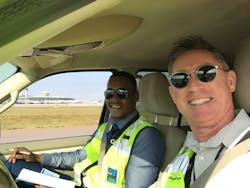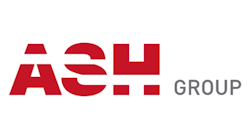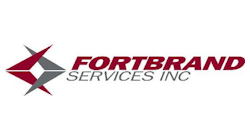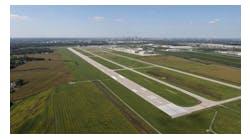At more than 5,600 acres, keeping operations safe in the airfield operations area at Dallas Fort Worth International Airport (DFW) is far from a small task.
There are 16,000 people who are licensed to drive on the airside of DFW, 1,000 of which can operate vehicles in movement areas. Keeping them and passengers safe on the roughly 2,000 flights per day traveling through the facility is a delicate task, which airport leaders take seriously as they train employees how to operate vehicles on the airfield.
“We handle it all internally,” Paul Sichko, vice president of operations, DFW said. “We create the training materials, we administer that through a learning management system, we track it all for the FAA.”
DFW leaders are concerned with runway incursions as they strive to eliminate any instances of inadvertent or unauthorized entry into the runway environment. . In Fiscal Year 2018, Sichko said there were seven at the airport, so they decided to bring all the training efforts in-house to help address concerns.
Building on standardized FAR Part 139 training, Sichko said the airport worked with a third-party vendor to build a customized program for DFW. Different areas and hotspots were recognized and filmed.
Anyone licensed to drive within the AOA area of DFW must undergo DFW Airport Board-provided training. If they pass, they’re granted ramp driving privileges.
Those licensed to operate in movement areas of the airfield have a more intensive six module training curriculum, along with mandatory simulator training and supervised practical training on the airfield.
Sichko said in addition to all federally required annual Part 139 training, movement area qualified drivers must undergo the simulator training every two years and there are plans to increase the frequency of practical ride checks.
“Within the last 18 months, we’ve reached out to all the tenants at DFW and said anybody who drives a vehicle inside the fence here at DFW, including taxi mechanics will no longer be able to take individual company training,” he said. “They will be required to take training provided by the airport.”
Tampa International Airport (TPA) undertook a comprehensive effort into its movement area training program in the past year. The airport has overhauled its program and who can access certain areas of the airfield, enhanced training and reduced the number of people with access to the airfield.
The airport also created a non-movement area training program for ground handlers and other employees in the ramp area, so they understand all the signage and markings. The employees must undergo the training whenever they renew their badges.
Adam Bouchard, director of operations for TPA, said the airport historically relied on video training for movement area training. The enhanced program includes classroom training, different levels of endorsement for the movement area. Those with the most access have to undergo more than 40 hours of training to ensure proficiency.
“Those who have access but may not be there all the time have to maintain a certain level of driving both daytime and nighttime out on the airfield and if they’re not able to maintain the proficiency requirement, then they lose it completely,” he said. “We don’t want people out there who occasionally go out and add unnecessary risk to the operation or the airport.”
TPA also certified training of airline mechanics allowed to taxi aircraft. They’re required to provide proof of training.
Tampa is updating its training annually in order to keep it fresh.
“Stale training, the same training every year is not effective,” he said. “It’s fresh every year. Some airports out there may look back and see the last time they updated stuff was years ago. People are going to expect what they expect and we should expect the same of them that their abilities would be stale too.”
DFW is taking further steps in 2021 with the opening of its new Integrated Operations Center (IOC). Part of the new facility includes staffing to control entry into the movement area by employees similar to how air traffic control coordinates aircraft.
DFW currently has an RFP issued looking for in-vehicle runway incursion warning technology for operators combined with the ability to track vehicles inside the movement area. That information will be live streamed into the IOC so they can see any vehicles coming from a non-movement area and dispatch resources if they inadvertently enter a ramp area. This will help prevent runway incursions or a surface incident.
“When our IOC opens, no one is going to be in the movement area without first talking to DFW airfield operations” Sichko said. “We’re going to track them with vehicle tracking, we’re going to know where they are, we’re going to know their call signs and we’re going to implement those procedures to further protect the runway environment.”
Invest time in snow removal training
DFW spent more than $30 million on new snow removal equipment in the past few years due to major ice storms hitting the Dallas area in the past decade and causing massive traffic snarls at the hub.
While leaders are now treating the airport as if it’s a northern hub, there hasn’t been a clearing event since 2015.
Steve Tobey, assistant vice president, airfield operations for DFW, said the airport maintenance teams will pull out the snow removal equipment during late summer and the fall and practice using it on runways and associated taxiways during the overnight hours. While that extensive training is common at most snow-belt airports, it is not common to practice for snow removal operations in 100° heat.
As snow and ice control is infrequent at DFW, the airport sends snow removal team members to industry conferences and to northern airports to ride along and learn best practices.
The Columbus Regional Airport Authority holds its own snow rodeo in the fall to help its operators get in shape for the season.
Joe Herrmann, airport operations manager for the Columbus Regional Airport Authority, said the event has formally taken place the past several years. Airfield maintenance staff competes in obstacle courses in friendly competition to work their skills in airfield snow removal equipment.
“For the airfield maintenance staff who haven’t driven in it for the past seven months and newer airfield maintenance staff, it’s an opportunity to get into the vehicle, you hear the noise, sense the largeness get the vibrations of moving that piece of equipment around and not hit a cone, which may represent an aircraft wing.”
The Columbus airfield maintenance staff hold a week of training on the snow removal equipment leading up to the snow rodeo event. The event is an equipment “maneuver and operation” timed and point scored obstacle course.
The rodeo is just one part of preparation for snow removal operations in Columbus. Herrmann said they start meeting with staff in October to discuss operations for the upcoming season.
Charles Goodwin, director of airport operations and aviation business services for the Columbus Regional Airport Authority, said they’re focused on standardizing processes on the airfield in terms of the routes cleared by staff.
“We design those routes, we train our crews on what those routes are and then we go out and have those drivers drive those routes dozens and dozens of times in many cases changing who the lead driver is to create familiarity with what that route is,” he said. “Just so that when we are in the middle of a snow event, we’ve formed a habit that we find is the safest way to handle snow removal.”
Learn about your equipment options
Tampa takes part in a sister city program, where they send staff to other airports to learn best practices and other technology from their peers. It allowed them to see equipment like continuous friction measuring equipment in action, which they could then bring back to Tampa and integrate.
“It gives our folks a chance to professionally grow,” said Brain Washburn, senior manager, airfield operations for TPA. “At the same time, they get to see on-site, not just in a letter or in a book or in an email and they get to bring that back to Tampa.
Columbus has acquired new snow removal equipment in recent years, including its first multifunction equipment, which allows them to enhance snow removal operations.
“It’s really about getting use to that equipment, seeing how much more efficient it is over the old and looking to tweak the current snow removal process,” Herrmann said.
Goodwin said the airport times every closure time with the new equipment to see if there are ways to make it more efficient and ensure it’s being used as effectively as possible while achieving a quality friction coefficient.
“It’s a quality issue, it’s an efficiency issue,” he said. “We have fewer operators than we’ve had historically and the quality of the work has gone up because we’re providing brooming on more services than we ever had before so it’s a higher quality removal.”
Alan Luke, regional sales manager for MB Companies, said multi-tasking equipment is a popular option for airports because they’re unable to find enough operators. Equipment with three or more options allows one operator to do three jobs to mitigate the operator crunch.
The operators receive training when they get the equipment, then Luke said they will operate snow schools for ongoing preparation for operators and mechanics.
“Before the start of the snow season we come in and do training on all their equipment and get their operators up to speed,” he said. “During long summers a lot of guys might forget and a lot of airports also have new people or seasonal employees.”
Airports need to adapt snow and ice removal plans when they move to multitasking equipment. It can change patterns for removal and grouping given how much faster it can removal snow.
“We come in and actually update their snow plans for them,” Luke said.
Luke recommended said airports need to consider storage for multitasking equipment given its larger than traditional equipment. Available storage space will dictate the equipment an airport can purchase.
“Believe me, it’ll cause a headache if you don’t think about it,” he said. “You can’t fit it through doors or you can’t fit it inside, which is a must if they’re using grant money to purchase the equipment.”
Since the mid 1990’s Fortbrand Services has been marketing and selling the Vammas PSB and ST/SB line of airfield snow removal systems as well as the Beam, Prinoth, Bergkamp and Wille line of multi-tasking maintenance equipment to airports throughout North America.
The Vammas PSB 5500 multi-tasking snow removal system was one of the first multi-tasking snow removal vehicle of its type to come from Europe and is still operating at most of the largest hub airports in U.S. and Canada.
With the use of its plow, broom and air blast, this equipment revolutionized snow removal processes throughout the nation. Andy Perrone, vice president airport maintenance equipment, Fortbrand Services, said during the “Do more with less” years, this was the answer to a quick and efficient runway and taxiway snow removal program while at the same time significantly reducing occupancy times on the airfield operating area.
Fortbrand Services now has over 200 Vammas Snow removal systems operating in North America and twice that many in Europe. A well proven snow and ice removal system.
“When airports decide to look at their airfield snow and ice control program, or re-evaluate the airport preventative maintenance plan, it almost always, requires the purchase of new and more productive equipment,” Perrone said. “This could be a costly endeavor and requires a thorough and detailed evaluation process not only on the type of equipment needed, but also the manufacturer you purchase from.”
Although, airports throughout North America use various programs to purchase high price tag vehicles, the process starts long before this juncture. It begins through the education, demonstration and proven customer support from a responsive and experienced vendor.
A dedicated sales team, operational and technical training professionals and after-market parts support specialists is what is needed to assure an airport management group that you will be there during the best as well as the worst times throughout the life of the equipment, Perrone said.
“We provide comprehensive post-delivery training to drivers as well as mechanical technicians, on call, 24-hour operational support as well as being on site during the first few snow events to assure the customer we are there for the long haul,” he continued. “If needed, we are also available to provide refresher training in the years following purchase.
Fortbrand also have seasoned ex-airport professionals on staff, Perrone, said, with many years of experience in the development of airfield snow removal planning who work with airport customers to establish an efficient snow routing plan so they get the most effective use of their resources. These are the qualities that an in-depth evaluation program must include in choosing a fully qualified and experienced supplier of these types of high-end equipment.
Knowing who your manufacturer/supplier, and what services they can provide, is paramount in developing a long-lasting partnership throughout the years to follow.
“The team approach in marketing and selling equipment of this type and price point requires each aspect of the team to be on point at all times. One weak link can result in a dissatisfied customer who has now lost confidence in your business and product,” Perrone said. “No matter how superior your offerings may be, a poor training program, a lost or delayed parts requests, an un-responsive maintenance and emergency needs call, can derogate not only the value of your equipment offerings but also how airports value your organization as a whole.
“Unfortunately, most distributers and manufacturers of these types of equipment are not fortunate enough to have the staff levels to the level that Fortbrand has, but a small productive team can cover the needs nicely.”





